NADA Show workshops focus on the untapped potential in used-car departments

Randy Barone of ACV (middle, on stage) during a "TEC Talk" at the ACV booth at NADA Show 2023. Photo by Joe Overby.
Randy Barone, vice president of business development at ACV, said many people often ask him how the used-car market will fare in 2024.
It’s a question he can’t answer, because “nobody can know that,” he said.
But what he does know is that most dealership used-vehicle departments are not “running on all eight cylinders — or in today’s market, I’d say all the batteries” and that it is a worthwhile endeavor to help dealers find and utilize their operations’ untapped potential.
Barone’s presentation, “How does your used car department score?” is among the workshops designed to do just that and to be presented during the National Automobile Dealers Association’s NADA Show 2024 event in Las Vegas, Feb. 1-4.
“If I can help your dealership do some of the things it’s not doing, as far as that untapped potential, the percentage of the market you’re concerned about being down is not really there at all because there is so much opportunity for you on the upside,” Barone said.
He has identified “pain points” and solutions gleaned from dealer group sessions that mostly focus on people, processes and inventory. Baron’s presentation encourages dealers to self-score in 10 areas on a scale of zero to 100.
For example, dealers who want to sell, say 100 used vehicles, should calculate how many marketing opportunities and closing rates they need to generate in order to make those sales happen, Barone said.
Virtually every dealer has access to that information via their customer relationship management systems that helps them monitor closing rates generated by customer touch points such as in-dealership floor traffic, telephone calls and online interactions, he added.
“If your closing ratio on those opportunities is ‘X’ and it equates to a great number of sales and you’re happy with it, then great,” he said. “If what you’re spending now is not generating enough opportunities to hit your goals then you need to re-look at it.”
Efficiency equals productivity
A highly productive reconditioning shop is also one that is highly efficient, according to Rapid Recon/Vehlo vice president of client services Anthony Martinez and its vice president of marketing and sales operations, Anthony Greenhalgh.
Martinez and Greenhalgh, who jokingly refer to themselves as the “two Anthonys” at their company, are to present their workshop: “Building a Reconditioning Operation,” during the NADA show.
Though software such as that offered by Rapid Recon/Vehlo can help dealers achieve a more productive reconditioning shop, it also helps when dealers also adopt workplace practices that identify and remove non-value added time, Martinez said.
Sometimes it’s as simple as having the right technician for the right job, Greenhalgh said.
Technicians who are trained to service a specific vehicle brand such as Ford or Toyota are highly skilled installers who can inspect and repair vehicles and their education and training is primarily dedicated to a specific brand, Greenhalgh said.
The reconditioning department doesn’t need that top-tier skill level and sometimes it will cost the dealership more money, Greenhalgh said.
For example, when dealing with a cracked headlight bracket, highly trained technicians are likely to replace the bracket because that is how they were trained. But a technician in the used-car department may repair the bracket which will fix the problem which can be more cost efficient for the dealership.
“We don’t make a technician turn a wrench any faster, we don’t make carpet dry any quicker and we don’t make a technician work any harder,” Martinez said. “We just remove the stuff that slows them down.”
A vehicle’s highest authentic value
Danny Zaslavsky, general manager of Country Hill Motors in Merriam, Kan., is also a proponent of using technology to manage used-vehicle inventory more efficiently.
In 2016, he became a co-founder of VINCUE, a software tool designed to manage every used vehicle from the point of acquisition to the point of sales with the goal of each vehicle out-performing the market and achieving its highest authentic value. VINCUE was introduced publicly in late 2018 and early 2019.
Zaslavsky’s workshop at NADA is titled: “Vehicle lifecycle management is the Next Horizon, are you ready?
He said he was motivated to create the product after he tired of constantly lowering his used vehicle prices to sell them, of those vehicle margins being compressed and of being told that he needed to purchase more and more technology to fix the problem.
VINCUE combines several industry tasks – such as appraisals, merchandising and syndication and vehicle acquisition into one software product.
“Efficiency adds scale; you don’t want to scale an inefficient dealership,” Zaslavsky said.
In addition to VINCUE advising dealers about what vehicles to buy in order to produce the best results, it tells dealers where to buy them and at what price.
Zaslavsky said the software also helps dealership groups by giving them insights into knowing which dealership within a given group is best suited to sell a used vehicle taken as a trade-in.
“One of our partners who has a big dealership group says ‘we used to behave like a group of dealers. Today we behave like a dealership group’,” Zaslavsky said.
Leave it to the logistics company
Cox Automotive Logistics is willing to go the extra mile, both literally and figuratively, to help dealers buy and sell vehicles.
That can mean arranging to move a vehicle to a nearby Manheim auction site to have it reconditioned to its retail ready condition and having it delivered to the retail customer on a flatbed truck, if that’s what the dealer that owns the vehicle wants, said Joe Kichler, vice president of Cox Automotive Logistics.
“It moves us from being just a logistics company to much more of a supply chain partner,” Kichler said. “We can help deliver that experience the dealer wants to have with the consumer.
“From a logistics perspective we can speed up their retail time.”
Kichler’s workshop at NADA is titled: “Evolution of Vehicle Logistics in Sales.”
Kichler said the need for such a service became magnified during the worst of supply chain constraints that occurred during the pandemic. Dealers often had a difficult time finding vehicles within their local markets to fit their consumers’ needs.
Though Cox Automotive Logistics owns no trucks to transport vehicles for dealers, it is a third party brokerage with over 5,000 carriers in network (with thousands more in the pipeline to join) that it can call on to move its customers’ vehicles.
Kichler also said Cox Automotive Logistics is making investments in several areas of software to enhance its offerings.
One such area focuses on building full loads for auto transport carriers to make things easier and more efficient for the carriers.
That’s because during COVID, auto sales were down and a tremendous amount of auto transport carriers — especially those who owned three or fewer trucks — left that space. As automotive capacity get back to normal there is likely to be a carrier shortage in the not so distant future, Kichler said.
“If we don’t invest in these technologies and capabilities, when we double how much volume is coming back though the wholesale channels from where we are today, that’s going to have huge impact on capacity that exists,” he said. “So, we’re trying to get in front of the impending capacity constraint.”

 View The Latest Edition
View The Latest Edition

